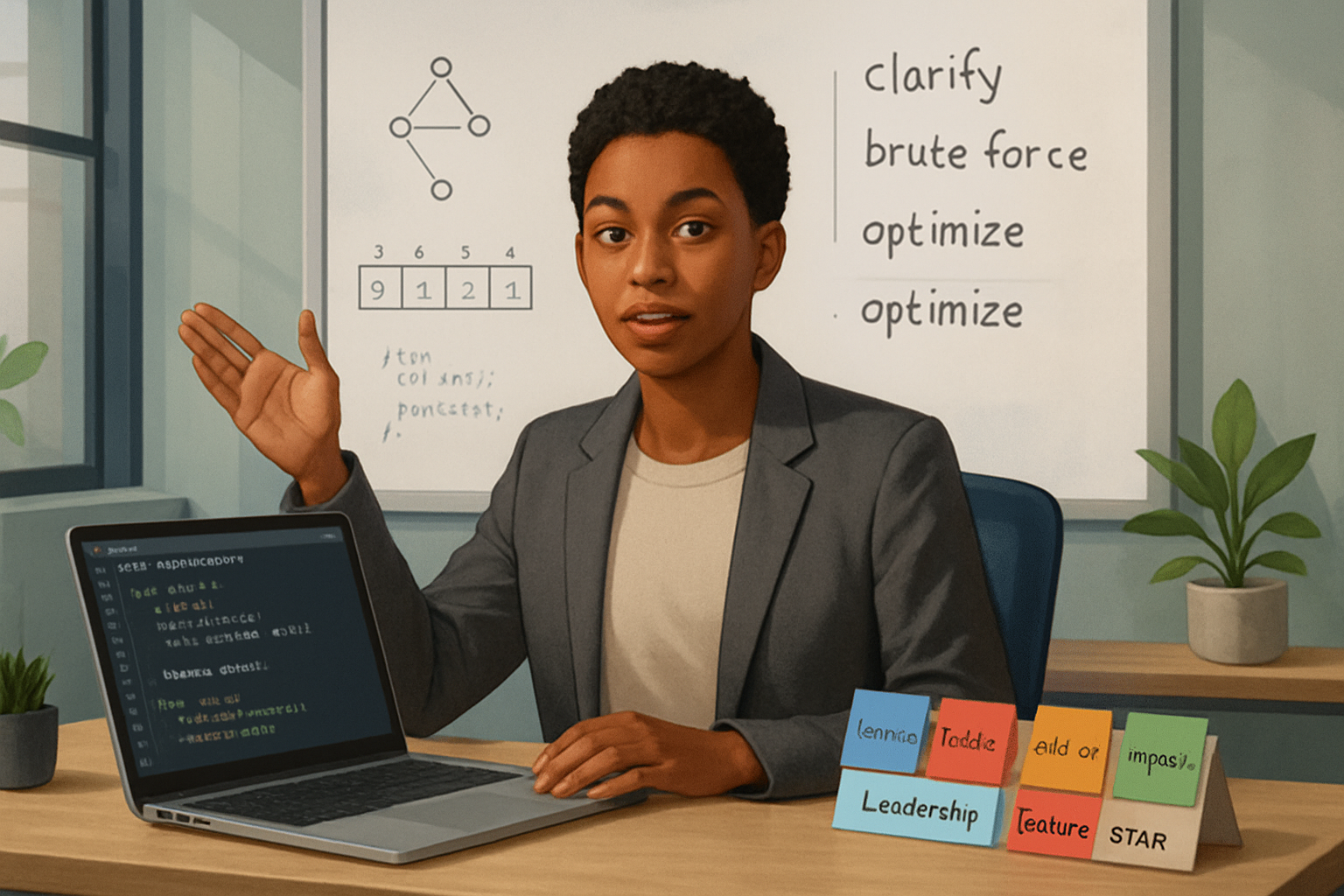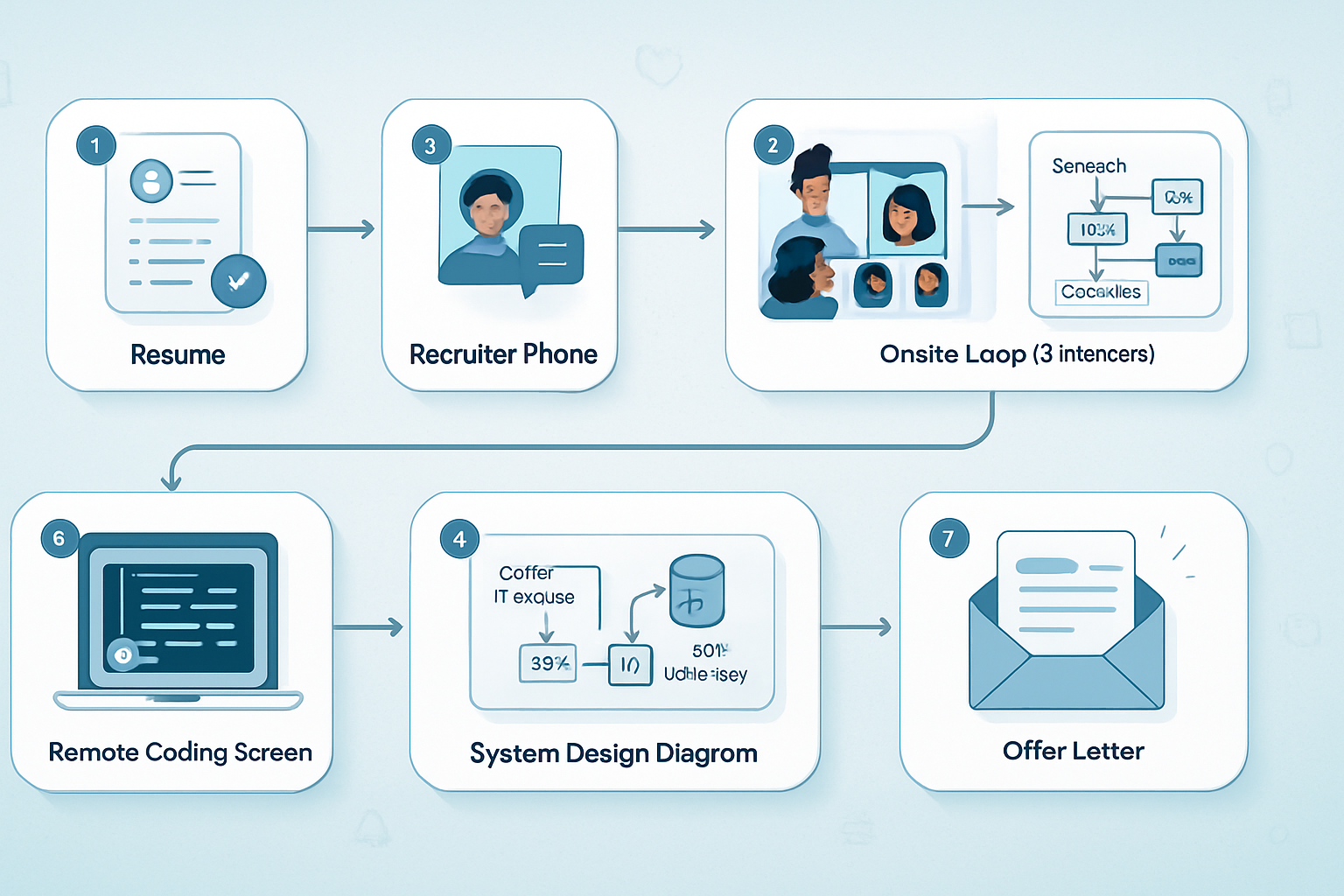· career · 7 min read
Decoding the Apple Interview Process: What You Need to Know
A practical, in-depth guide to the Apple software engineer interview: stages, what interviewers look for, tactics to excel at each step, sample technical questions with solutions, system-design checkpoints, and behavioral prep using STAR.

Overview
Landing a software engineering role at Apple requires more than strong coding ability - interviewers evaluate problem solving, system design, communication, product sense and culture fit. This guide walks you through the typical stages of the Apple interview process, what interviewers expect at each stage, concrete tips to impress, and example technical problems with solutions.
References and further reading:
- Apple’s careers page: https://www.apple.com/careers/
- Community interview overviews on LeetCode: https://leetcode.com/discuss/general-discussion
- Candidate experiences on Glassdoor: https://www.glassdoor.com/Interview/index.htm
Typical stages of the Apple software engineer hiring funnel
While details vary by role and level, these are the common stages you should expect:
- Resume / Recruiter screen
- Recruiter checks fit, confirms role/level, asks about location/authorization and schedule availability.
- Initial phone or video screen (30–45 min)
- Usually with a recruiter or hiring manager. May include one coding question (collaborative editor) or discussion of background and projects.
- Technical phone/video interview(s) (45–60 min)
- Live coding on a shared editor (data structures/algorithms). One or two rounds prior to onsite for some teams.
- Onsite interview loop (4–6 interviews, 45–60 min each)
- Mix of algorithmic coding, system design (for senior roles), low-level design or debugging, and behavioral/product sense interviews. Interviews may include pair programming-style questions.
- Hiring manager conversation & team fit
- Deeper discussion of your role expectations, projects, and career trajectory.
- Hiring committee & executive approval
- Apple uses a committee to standardize offers and calibrate levels.
- Offer & negotiation
- Compensation, start date, relocation, and other details.
Note: For new grads the loop may focus more on core algorithms and data structures; for senior roles there will be heavier emphasis on system design, architecture, and tradeoffs.
What interviewers are assessing (the core axes)
- Problem solving and algorithmic thinking (can you break down a problem, choose an approach, prove correctness?)
- Coding correctness and clarity (clean code, edge cases, tests)
- Complexity awareness (time/space trade-offs)
- System design and architecture (scaling, APIs, data models)
- Product sense and pragmatism (trade-offs with deadlines and constraints)
- Communication and collaboration (explain decisions, incorporate hints)
- Culture and behavioral fit (Apple’s values: craftsmanship, privacy, obsessing about customers)
How to prepare for each stage - practical tips
Resume & recruiter screen
- Tailor your resume to the role - highlight relevant projects, measurable impact, and technologies used.
- Be ready to succinctly describe any project or line on your resume (the recruiter might ask follow-up questions).
- Prepare a quick pitch (30–60s) that summarizes who you are and what you’ve shipped.
Phone / video screen
- Clarify assumptions quickly, outline plans before coding, and talk through your thought process.
- Use the shared editor fluently (practice on platforms like LeetCode, HackerRank, or a collaborative editor like CoderPad).
- If you get stuck, verbalize your stuck point and propose alternatives - interviewers value reasoning.
Technical interviews (coding)
- Practice common patterns: two pointers, sliding window, hashing, heaps, DFS/BFS, dynamic programming, greedy, union-find.
- Focus on writing correct, readable code and handling edge cases.
- Write tests or walk through examples to demonstrate correctness.
- State and analyze the complexity (big-O) clearly.
System design & architecture
- For senior roles, prepare large-scale designs (distributed systems, databases, APIs). Use a structured approach: requirements, API design, data model, storage, scaling, caching, consistency, failure modes.
- Practice by designing systems such as URL shorteners, chat services, news feeds, search indexes, or rate limiters.
- Be explicit about tradeoffs: consistency vs availability, load balancing choices, and monitoring/metrics.
Behavioral & product sense
- Prepare stories using the STAR format (Situation, Task, Action, Result).
- Expect product-oriented questions: “What would you change in X Apple product?” or “How did you prioritize a conflicting stakeholder request?”
- Demonstrate ownership, user empathy, and technical leadership.
On the day of an onsite (or loop)
- Bring a notepad; sketch designs and show your diagrams.
- Ask clarifying questions before coding. Interviewers value communication.
- If you finish early, optimize or discuss alternative approaches.
- End each interview by summarizing next steps and thanking the interviewer.
Example technical questions (with concise solutions)
Below are representative problems that mirror the types you may see. Answers include high-level approaches and sample Python code for clarity.
1) Two Sum (classic warmup)
Problem: Given an array nums and a target, return indices of two numbers that add up to target.
Approach:
- Use a hash map to store value -> index seen so far.
- For each num, check if target - num exists in the map.
- O(n) time, O(n) extra space.
Sample code (Python):
def two_sum(nums, target):
seen = {}
for i, val in enumerate(nums):
need = target - val
if need in seen:
return [seen[need], i]
seen[val] = i
return NoneDiscussion tips: explain why hash map works, handle duplicates and clarify whether you should return indices or values.
2) Merge k Sorted Lists (priority queue)
Problem: Merge k sorted linked lists and return it as one sorted list.
Approach:
- Use a min-heap of current node values from each list.
- Pop smallest, attach to result, push next from that list.
- Complexity: O(n log k) where n is total nodes.
High-level pseudo-code:
import heapq
def merge_k_lists(lists):
heap = []
for i, node in enumerate(lists):
if node:
heapq.heappush(heap, (node.val, i, node))
dummy = tail = ListNode(0)
while heap:
val, i, node = heapq.heappop(heap)
tail.next = ListNode(val)
tail = tail.next
if node.next:
heapq.heappush(heap, (node.next.val, i, node.next))
return dummy.nextDiscussion tips: explain stable ordering using index tie-breaker; discuss memory usage and alternative divide-and-conquer merge.
3) Detect cycle in a linked list (Floyd’s algorithm)
Problem: Detect if a linked list has a cycle.
Approach:
- Use slow and fast pointers. If they meet, cycle exists. To find start node, reset one pointer to head and advance both.
- O(n) time, O(1) space.
Code sketch:
def detect_cycle(head):
slow = fast = head
while fast and fast.next:
slow = slow.next
fast = fast.next.next
if slow == fast:
# find cycle start
slow = head
while slow != fast:
slow = slow.next
fast = fast.next
return slow
return NoneInterview tips: explain invariants and why resetting slow to head works.
4) System design: Design a URL shortener (high-level)
Key requirements:
- Create short alias for long URL and redirect in O(1).
- Handle high read traffic, moderate writes, analytics optional.
Design steps:
- Requirements: reads vs writes, custom aliases, TTL/expiration, analytics.
- API: POST /shorten {url, custom_alias?} -> short_id; GET /{short_id} -> redirect.
- Data model: table mapping short_id -> (long_url, created_at, expiry).
- ID generation: base62 encode a unique integer (from a DB sequence) or use hash + collision handling; for distributed generation, use prefix shards or Snowflake-like IDs.
- Scaling reads: use CDN + caching (Redis) to serve redirects; primary DB used for writes.
- Availability: replicate DB across regions; use consistent hashing for cache; implement rate limiting.
- Monitoring: count hits, latency, 4xx/5xx rates.
Interview tips: be explicit about tradeoffs (short predictable IDs vs random ones, collision strategies, cache invalidation) and show scaling estimates (QPS, storage).
Behavioral questions & STAR examples
Common behavioral prompts:
- “Tell me about a time you disagreed with an engineer or product manager.”
- “Describe a technical decision you owned end-to-end.”
- “Tell me about a time you encountered a production incident.”
STAR outline example (incident response):
- Situation: Production outage caused by a bad deployment affecting login flow.
- Task: Restore service and diagnose root cause while informing stakeholders.
- Action: Rolled back deployment, enabled feature flag, ran post-mortem, added automated tests and a canary rollout.
- Result: Service restored in 8 minutes, similar incidents reduced by 80% after safeguards.
Tips: quantify impact, show ownership and learning, and close with what you changed to prevent recurrence.
Common pitfalls and how to avoid them
- Silence during an interview: always narrate your thought process.
- Jumping into code without clarifying: take 1–2 minutes to define constraints and examples.
- Not testing your code: run through sample tests and boundary cases.
- Ignoring tradeoffs in design: always compare alternatives and state why you chose one.
- Overusing micro-optimizations too early: get correct solution first, then optimize.
Leveling and compensation (what to expect)
Apple uses leveling similar to other FAANG firms; titles and levels vary by team. Compensation packages typically include base salary, restricted stock units (RSUs), and possible signing bonuses. Research comparable offers using resources like Levels.fyi and Glassdoor, and be prepared to discuss expectations with the recruiter.
References:
- Candidate compensation and leveling resources like https://www.levels.fyi
- Glassdoor interview experiences: https://www.glassdoor.com/Interview/Apple-Interview-Questions-E1138.htm
Final checklist before interviews
- Practice 20–30 medium+ algorithm problems across categories.
- Do 5–10 timed mock interviews with peers or platforms (e.g., Pramp, Interviewing.io).
- Prepare 6–8 STAR stories covering leadership, conflict, impact, and failure.
- For design rounds, rehearse 3–4 end-to-end high-level systems (e.g., URL shortener, feed, messaging).
- Sleep well and arrive early (or ensure your setup for remote interviews - camera, mic, editor - is ready).
Closing note
Apple interviews reward clarity, thoughtfulness, and strong engineering judgement. Balance coding correctness with clear communication and product-minded tradeoffs. Use structured approaches in both algorithmic and design problems, and practice explaining your thinking - interviewers remember how you approach problems as much as the final answer.



